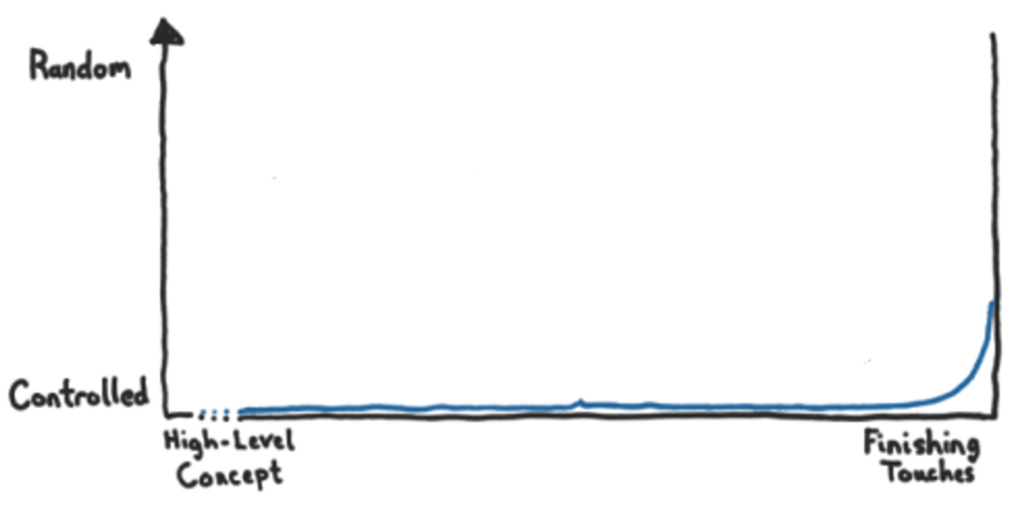In graphic design, the mix of order and chaos is interesting and exciting. From abstract design to interactive user experiences, the strategic use of randomness has the power to captivate and engage audiences by adding an element of surprise, chaos, and energy to visual compositions. In this blog entry, I will explore how designers can use randomness and chaos to create creative and interesting graphic design projects. In researching this topic, I wanted to get some ideas from the concept of randomness in graphic design and explore its role in creating visually compelling and dynamic designs. To gain insight into the potential of randomness to enhance rich and innovative user experiences, I explored how randomness can be used as a design resource. I also investigated the incorporation of randomness into the composition of artwork, with a focus on its contribution to the creation of unexpected and surprising outcomes.
Randomness in Abstract Design
Abstract design is an art style that breaks away from traditional forms and embraces free-flowing and organic elements. It creates beauty through unexpected combinations of colors, lines, and shapes, and can be seen in various mediums such as painting, printmaking, and digital art. In digital art, randomness emerges as artists use algorithms and code to generate unpredictable patterns and shapes. Too much structure can make abstract design boring and predictable, so finding the right balance is crucial to creating engaging and effective artwork. As an example from one of my previous blog posts, Jackson Pollock, often called the „Father of Abstract Expressionism,“ provides a notable example of randomness in abstract design. His famous drip paintings from the mid-1940s feature random drips and splashes of paint, resulting in a chaotic and energetic composition. Incorporating random elements adds depth and complexity to the artwork, making it more engaging and dynamic. 1
Randomness as a Resource for Design
The research paper „Randomness as a resource for design“ argues that randomness can be used as an innovative design resource for supporting rich and novel user experiences. Randomness in design does not follow any rule, method, direction, or pattern. If a project calls for randomness, it is best to start with materials that are conducive to spontaneity. Designing with type requires adept handling of the hierarchy, refining and designing the display elements for focal emphasis and also refining the quiet details. Random compositions exhibit visual qualities that are not patterned, aligned, or horizontal. Instead, they tend toward compositions that exhibit overlapping, cropping, angling, and textures. This approach allows for the creation of a dynamic and fresh composition.2
Randomness in the Composition of Artwork
The use of randomness in the composition of artwork has been a subject of interest for many artists. Great artwork requires great attention by the artist. Even so, many artists acknowledge that randomness and spontaneity also play a role in great works. Some visual arts have also utilized randomness, and programmatic artwork may provide an interesting way forward. Not only is it easy to introduce randomness at any point in the composition, but the randomness itself can be controlled in many ways. Furthermore, random experiments can be rapidly replayed. This allows the artist to observe the outcome and take an iterative approach. In some ways, the artist is merely setting up a perfect environment to discover great works of chance.
In his article Tyler Hobbs talks about how artists use randomness in their art to make unique and interesting creations. In his conclusion, understanding and purposefully using randomness can help create special works of art.
How artists use randomness varies. Some carefully control every part, creating polished works (Figure 1), while others intentionally leave things imperfect and spontaneous, adding a touch of chance (Figure 2).


Hobbs also suggests that a type of art called programmatic artwork, seen in things like Sol LeWitt’s wall drawings, is a good way to explore randomness. It allows artists to add randomness at different points and control it. It also allows them to quickly try out different random ideas to see what works best.
In Hobbs’ own work he talks about, the Quilt and Continuity series, randomness is an important part. In the Quilt series (Image 1), a random starting point guides each new layer, and in the Continuity series (Image 2), semi-random shapes and layers are influenced by a chosen point. 3


The randomness scale for these series shows a lot of variation, like the following Figure shows.

Conclusion
In conclusion, the strategic use of randomness in graphic design projects, particularly in abstract design, as a resource for design, and in the composition of artwork, can lead to visually compelling and dynamic outcomes. By embracing randomness as a creative tool, designers and artists can infuse their work with a sense of dynamism, playfulness, and innovation, ultimately creating designs that resonate with audiences on a deeper level.
Sources:
- https://blog.designs.ai/2023/02/10/exploring-the-world-of-abstract-design-tips-and-techniques-for-designers/ ↩︎
- Tuck Wah Leong, Frank Vetere, and Steve Howard. 2006. Randomness as a resource for design. In Proceedings of the 6th conference on Designing Interactive systems (DIS ’06). Association for Computing Machinery, New York, NY, USA, 132–139. https://doi.org/10.1145/1142405.1142428 ↩︎
- https://tylerxhobbs.com/essays/2014/randomness-in-the-composition-of-artwork ↩︎